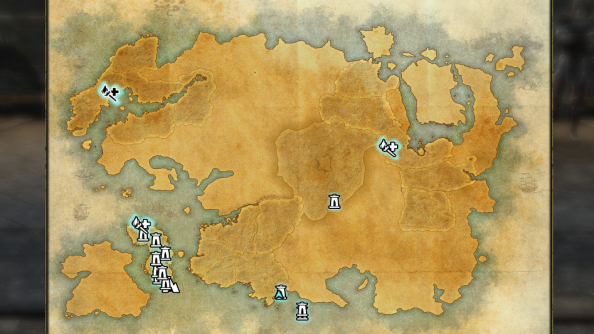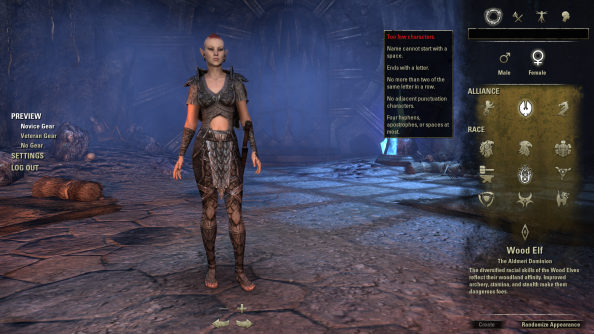The Elder Scrolls Online is a mess.
Somewhere, buried under bugs, often bizarre design decisions and weird rookie level structural mistakes that the game makes, there is a great MMO struggling to be found.
I played it for just over 30 hours, reaching level 16 (of 50) and the third zone in my faction’s territory. Yes, the game is huge: Zenimax weren’t joking when they announced the 150 hours average game time to end-game. But there were plenty more reasons why it took me so long to get even this far, and the majority of them were due to an endless torrent of progress-halting bugs.
The Elder Scrolls Online is just not ready for players.
It is a tragedy.
To recap, quickly. There have been single player Elder Scrolls games for over a decade. They are open world RPGs that focus on exploration and player choice. They sell a dream: go anywhere in their world, and be a hero.
The Elder Scrolls Online sells a different dream. Go anywhere in the world and be as much of a hero as the others. It looks and sounds and occasionally feels like a traditional Elder Scrolls game. All the elements that make it feel familiar are there: it includes a system allows players to develop interesting hybrid player classes. It is fully voiced. It shares an art style. Even the cursor looks Elder Scrollsy.
It is set in the same universe; roughly 1000 years before the events of Skyrim, the last game in the series. A Daedric Prince named Molag Bal is attempting to weld twin planes of existence: Tamriel (our home) and Oblivion (hell, sort of). After freeing yourself from Coldharbour – Molag Bal’s sadistic prison of souls – It’s up to you to stop his diabolical plans, with the help of everyone else.

You have a choice of three player factions: the Ebonheart Pact, Daggerfall Covenant and the Aldmeri Dominion. Each faction includes three races, unless you pre-ordered the game which will open up all races to each faction. You’ll also be unable to play as the iconic Imperial race, unless you pay extra for the collectors edition (£69.99 or $79.99). That point feels like a cash grab. It leaves a sour taste.
There are other weird restrictions. You’ll never see a player from the opposing faction aside from in battle: their areas are roped off until you reach the maximum level of 50. And even then, when you enter those areas, thanks to the way the game instances these zones, you’ll only see players from your own faction. It portrays the world as an artificial biodome full of NPCs: it just drains the immersion and life right out of it.
It’s a big game though: in the image above the dark and bordered areas are the currently playable zones in Tamriel. The rest is inaccessible, and there’s a great deal of it. Naturally there needs to be post launch content and expansions, and you need a place to put them. The playable areas are big: for some context the small island in the bottom left populated by various icons took me a good 20 hours to complete.

Elder Scrolls Online’s character creation and customisation is actually impressive – it’s probably the best thing about the game. Creation feels right: there’s all the sliders you could want to fine tune your look, and picking between one of the four classes: Dragonknight, Sorcerer, Nightblade and Templar is a hard problem.
That’s because any class can use any of the available weapons and armour just like Elder Scrolls fashion. You could dress your Orc Sorcerer in medium armour and augment his two handed sword with fireballs. Maybe you want to use a bow from afar as a Wood Elf, but also fall back on some healing magic from the Templar class. This is genuinely exciting and forward thinking, and Zenimax Online deserves real credit for being brave enough to follow through with a character class system that is a world ahead of traditional MMO archetypes.
Combat is interesting, but clunky. It’s uses a combination of pre-determined action bar skills, and real-time weapon swinging. Clicking with your left mouse will let you swing or fire your weapon, whilst the right button enters a blocking stance. Enemies telegraph powerful attacks – if they’re blocked, you can stun and knock them back.
Each weapon set can hold upto five skills and an ultimate ability, which you can mix and match from weapon and class abilities. When you reach level 15 you can have two weapon sets on the fly, each with their own set of abilities. As you use these abilities and weapons, they will begin to level up and eventually will be able to be morphed. Morphing gives you a choice between two upgraded variants of a specific skill, further tailoring to your style of play.
There’s a real density to the choices ESO is offering you. You can heavily invest in one archetype alone or split it between two – which you can change at a weapon swap. Skills can be swapped on the fly as long as you’re not in combat too, so you can be versatile in the situation at hand. You can pay a hefty fee to reset all your spent skill points, so at any point in the game every weapon/armour combination is open to you. This sort of freedom should be the standard for future MMOs.

Elder Scrolls Online is about quests. And in principle, they’re not bad.
You’re rarely asked to kill ten rats or a similar equivalent. It’s a bit more natural. Quests are always related to an overarching narrative, and are delivered by some quality voice acting. Sometimes you can recognize a reuse of a certain actor, but it’s the smallest of nuances. You’ll find yourself involved with complex conspiracies, heated family feuds and a weird abundance of vengeful ghosts.
Sure, you’ll be killing lots of monsters in between, but only because they’re en route, and not because a quest tracker is telling you to.
You’re not constantly directed by the quests, too. Most you discover for yourself by exploring, and there’s always the main quest – to combat the forces of Molag Bal, nagging at the back of your mind. Then there’s also your faction quest line – a set of objectives in aid of your chosen faction.
Being in the Aldmeri Dominion I was one of Queen Ayrenn’s agents – aiding her bid for acceptance among the people while foiling the plans of her silent enemy: the Veiled Inheritance. It’s a big political drama, smoothed over by one of my favourite characters in the game: Razum-Dar. He’s a sharp Khajiit, another agent of the queen and your mentor. His writing has had me laughing on a number of occasions and I absolutely adore him.
Compare that to the main quest which is just… rubbish.
While the faction quest line follows you around in your exploration, the main story line doesn’t. Instead, every few levels The Prophet – played by Michael Gambon and your guide in your war against Molag Bal – will magically appear next you with the rehearsed request: “Vestige, I must speak with you”. You then have to stop whatever you’re doing, fast travel to meet with him, and then complete whatever task he has before you. Rinse and repeat. It’s a stiff, weird interruption that feels disjointed and alone from the entire world.

Beyond the principle, there’s the practice. And in practice, Elder Scrolls Online’s questing content is a disaster.
Every MMO launch is often plagued with a few bugs that fall through the net of QA and public betas, but with TESO it’s an epidemic. NPCs and items often break altogether: not performing their scripted actions, become invisible or refuse to interact with you and some would just refuse to spawn at all. You’ll often see players huddled around the affected area, waiting for a miracle.
Fixing these problems as a player is ludicrous. Sometimes, you’ll find it’s a UI issue that can be reset via a simple slash command. But more often than not you would be forced to repeatedly log out and in again until you were slotted into an instance where the quest was still working. On some occasions I was lucky in just a couple of tries. In others I ended up giving up on playing for the night.
Quest bugs aren’t the only bugs. They’re just the most obviously visible. But they’re not the most frustrating.
For example: the game has a habit of forgetting that you upgraded your bank tab, and will revert to the standard size. With it, any items stored in the tabs would be lost forever.
For example: occasionally upgrading an item via crafting with a “100% success rate” will fail, destroying the item in the process.
For example: sending a cash on delivery mail to another player, when your mailbox is full results in the item being handed to the player, for free.
For example: a dupe bug has recently been discovered that has completely annihilated the game’s economy.
For example: I could go on all day.
Since early access and the game’s release just under two weeks ago, there have been two small patches, but it’s barely dented the scale of the problems Elder Scrolls Online faces.

At level 10, you’ll unlock Elder Scrolls Online’s player versus player mode, where all three factions take part in a giant, open world royal rumble. You’re fighting to take and hold the Ruby Throne, centred in the Imperial City.
If your faction captures all the keeps surrounding the Imperial City, then their top ranked player dons the Emperor’s clothes and gains some god-like powers for the duration. It’s a fun system which rewards good play, and everyone can fantasise about that dream of attaining it one day.
Being on a single map, there’s usually no more than one or two large battles taking place at any one time. The skirmishes themselves feel really smooth, and I never noticed a performance/server hitch spoiling the fun. It can be brilliantly atmospheric, thanks to judicious use of weather effects: I felt goosebumps as fog rolled in from the hills and the roar of thunder echoed across the battlefield.
The issue with PVP is a lack of progression. You earn experience for killing your opponents, taking keeps and completing bounties, but in very low quantities. Every hour I spent in Cyrodiil, I couldn’t help but feel I would’ve made ten times the progress with my character if I sticked to questing. This feels like a significant misstep. PvP in Elder Scrolls Online is good, but it feels like you’re punished for playing it.

What else is there to do outside of questing and PvP?
Dungeons are simple affairs that don’t offer much challenge. This could be remedied later on in the game as players get geared and experienced (I’ve heard good things from friends), but first impressions aren’t great. Bosses are tedious one note fights, that mostly revolve around a single mechanic. If you fail to jump through the required hoop, it will one shot you. Dungeons are also littered with first come, first served chests. Loot from them is not shared with your party. They will cause relentless arguments within your party: I’ve repeatedly seen players abandon their group mid-combat to claim the treasure.
Delves are smaller dungeons that are public, and not instanced. Many have quests associated with them, while others are there simply to be raided. All come with an end boss, some loot and achievement for completing them.
But they are inept. They are always overpopulated – which could be a side effect of the launch – and the end-bosses are being farmed by armies of bots, who appear to be using the (actually quite good) loot to fuel their gold-farming/selling sites. Getting credit for the kill on a delve boss is usually not worth the effort.
The open world is way more fun. Exploring it, and the gorgeous environments Zenimax have crafted, is a real pleasure. It really is a pretty game and runs well. On my three year old system (i7 2600k @ 4.4GHZ, GTX 580, 8GB of RAM) I managed to crank up the graphics to maximum with zero performance issues.
You are deftly rewarded for heading off the beaten path: discovering Sky Shards (stones that emit a blinding light) will award a skill point for every three you collect. Finding all 336 is quite the achievement.
Crafting in Elder Scrolls Online is an oddity. You can pick flowers, mine ore, chop wood, extract runes, capture butterflies, and then use the materials to improve your weapons and armour. There’s no need for gathering skills or equipment: every node is available to every player. That does to a bit of a bunfight for nodes, and I think that instancing the crafting nodes per player would have been a better option.
Upgrading your items is strange. You can upgrade items from normal, to legendary quality, but it’s based around a percent chance of success. Failure will destroy the item entirely. Your chance of success can be improved by collecting more of a required material, but these are rare drops. You can research specific affixes like ‘increased stamina’ or ‘deal X fire damage’, but again, researching destroys the initial item. It’s a grind, and a rather dreary one at that: it feels like a wasteful process, but the end rewards are exceptional. Crafted items are the best available, even better than looted ones.

The Elder Scrolls Online is frustrating. It has moments of sheer class, but they’re consistently tainted by bugs. I love the PvP, but it’s pointless playing when the rewards are so slim. I like the questing, but huge numbers of quests are simply broken. I love the world, and the lore, and some of the systems they have produced. But my enjoyment of them was undermined by poor design.
There is a contradiction at the heart of Elder Scrolls Online: the delicate balance between making a game for fans of the Elder Scrolls single player games, and making a game for MMO players. Those who like the single player games will enjoy exploring that world, but the subscription model will continue to bite. And it’s hard to get round the fact that you just one of many thousands of “chosen ones”.
For MMO players not particularly wedded to the Elder Scrolls lore, there are just many better made, better produced, and better designed MMOs available.
Zenimax have a lot of work ahead of them to turn TESO around.
5/10
MMOs are huge by nature, and it takes time to see everything they have to offer. I always usually give every MMO a run for its money by reaching the end-game before review, but for good reasons TESO’s pace is slower than most. Even with 30 hours of play time I hardly made a dent. I will continue to play TESO in my spare time in an attempt to reach the max level, and then some. If I feel that the review should be updated and/or changed, I will make additions based on my experiences.
